Friday, 7 December 2012: Welington, the Botanical Garden
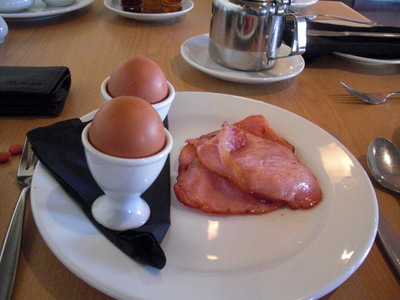
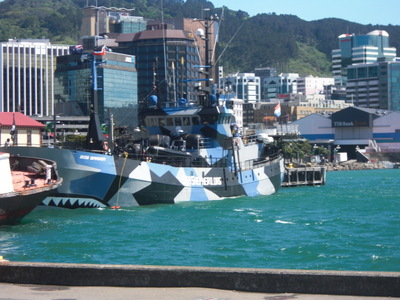 Thursday night, when we got back to the hotel, we both noticed a little poster in the elevator advertising an "express breakfast"—two eggs, bacon, toast, and coffee—just what we'd been wishing for all week. My attempts to find someplace outside the hotel where we could eat breakfast had not met with success—most places didn't open early enough. We had a nice continental at the Hippo, but it was ridiculously expensive.
Thursday night, when we got back to the hotel, we both noticed a little poster in the elevator advertising an "express breakfast"—two eggs, bacon, toast, and coffee—just what we'd been wishing for all week. My attempts to find someplace outside the hotel where we could eat breakfast had not met with success—most places didn't open early enough. We had a nice continental at the Hippo, but it was ridiculously expensive.
The next morning, the poster was gone, but we asked about it and, sure enough, we could have been ordering the "express breakfast all along—it just wasn't mentioned on the menu, in the elevator posters, or by the servers. You just had to know about it, I guess!
At the right is another view of the Sea Shepherd we got on the way to Te Papa, showing the toothy jaws painted on its bows.
I worked for a little while at Te Papa, then set off for the cablecar and the botanical garden.
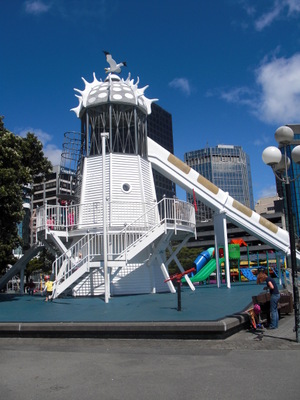
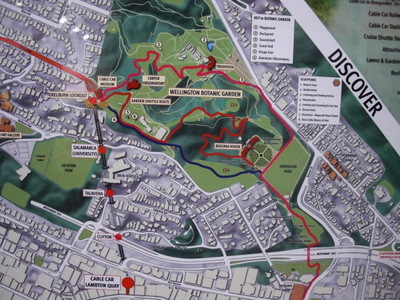 On the way, walking along the waterfront, I stopped to admire this childrens'slide in the shape of a lighthouse. I've given this wonderful section of the harborfront rather short shrift in my desciptions, but in our various walks back and forth past and through it, we came across many wonderful features—monumental works of art, play areas, footbridges, whimsical structures like the slide.
On the way, walking along the waterfront, I stopped to admire this childrens'slide in the shape of a lighthouse. I've given this wonderful section of the harborfront rather short shrift in my desciptions, but in our various walks back and forth past and through it, we came across many wonderful features—monumental works of art, play areas, footbridges, whimsical structures like the slide.
At the right is a map set into the wall of the little alley leading to the base of the cablecar. It diagrams the cablecar route, the circlar drive at the top, and the botanical gardens. The "Carter Observatory," in the gardens, is the third attraction offered as part of the city-pass package, the one I didn't choose. I never found out anything about the "garden shuttle" whose route is diagrammed, but the other red line (the one north of the words "Wellington Botanical Garden") is the one I took.
While I waited for the cablecar, I ducked into a nearby food court and acquired a picnic lunch.
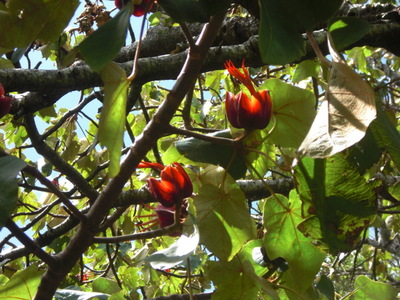
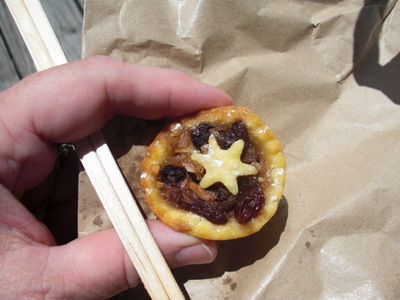 I had seen signs earlier indicating a "down-hill walk to the city" through the gardens, and sure enough, the volunteers on duty at the garden entrance, right next to the cablecar terminal, were eager to point out to me the pink flowers stencilled on the paths to show the way. Just at the beginning of the route was this spectacular "hand tree" (Chiranthodendron pentadactylon), in full bloom. Each "five-fingered" stamen is almost as large as a hand.
I had seen signs earlier indicating a "down-hill walk to the city" through the gardens, and sure enough, the volunteers on duty at the garden entrance, right next to the cablecar terminal, were eager to point out to me the pink flowers stencilled on the paths to show the way. Just at the beginning of the route was this spectacular "hand tree" (Chiranthodendron pentadactylon), in full bloom. Each "five-fingered" stamen is almost as large as a hand.
As promised, the whole route was downhill except for a couple of very short gentle uphill stretches (not more than 10 yards each). I stopped at the midpoint—the visitor center called the Treehouse—looked at its exhibits, and then ate my lunch on its deck, overlooking the gardens—a little box of salmon sushi and two tiny mince pies, each topped with an even tinier pastry star (mince pies are a Christmas tradition in New Zeland, so large and small ones were on sale everywhere). I walked the whole marked path, but in addition I made many excursions off it to look at particular sections of the garden or architectural features.
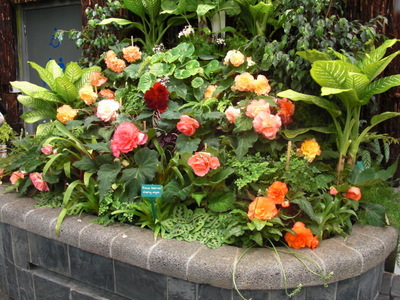
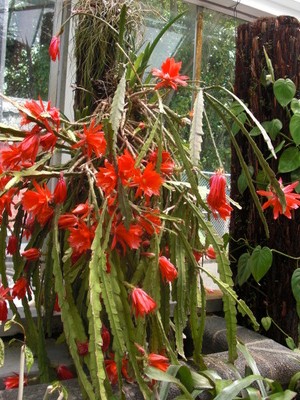 Near the bottom I stopped off to tour the glass house, which is famous for its collection of begonias (left) but also shelters many other species, as illustrated by this spectacular Christmas cactus (right).
Near the bottom I stopped off to tour the glass house, which is famous for its collection of begonias (left) but also shelters many other species, as illustrated by this spectacular Christmas cactus (right).
It has an adjacent restaurant, which was serving what looked like pretty good lunch, but the place was mobbed, so I'm glad I didn't try to eat there. My peaceful picnic at the deserted visitors' center was much preferable.

 After wandering around for a while in the geometrically laid out rose gardens, I continued down the hill into the city, across a foot bridge over the freeway, past the post office, the behive-shaped parliament building (left), and these monumental sculptures (right) and all the way along the waterfront back to Te Papa.
After wandering around for a while in the geometrically laid out rose gardens, I continued down the hill into the city, across a foot bridge over the freeway, past the post office, the behive-shaped parliament building (left), and these monumental sculptures (right) and all the way along the waterfront back to Te Papa.
Once again, I had timed well and got back to Te Papa just as the annual business meeting, the last session of the whole deep-sea meeting, broke up. The vote and been taken and the decision announced—the next round of meeting will be in the summer of 2015 in Aveira, Portugal! We'll be there with bells on. I even already have the phrase book, left over from the meiofauna meetings in Recife.
The big bombshell, though, was that the competing proposal for the 2015 meetings came from Tallahassee! David spent about an hour afterward fending off nudges and winks from colleagues, kidding him about keeping the idea so dark and springing it as a surprise on the day—but no, honest, it came as a complete surprise to him and to me. The proposal was conceived and presented by a new associate research faculty member just hired at the FSU Coastal and Marine Laboratory, whom we haven't even met yet. I'll be interested to see whether the proposal is renewed next time, in Aveira, for the 2018 meetings.
As the meeting broke up, each person in attendance was presented with a small souvenire abalone shell, about three inches long, each with a tiny museum-specimen number affixed to the back. I packed David's for him, even though the chances were good that it would be confiscated either by the Australian by the U.S. customs people. As it turned out, though, we got it all the way home. I didn't even have to present it for inspection—I just called it a "museum specimen" and described it for the customs officer, who let it go just like that.
After resting our feet for a while back at the hotel, we joined British colleague Gordon Paterson and his wife Greta for dinner. On their recommendation, we went to Chow's for pan-Asian food. It was the sort of place where you order dishes to share around, so we selected an assortment.
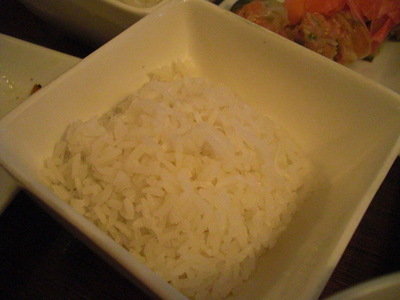
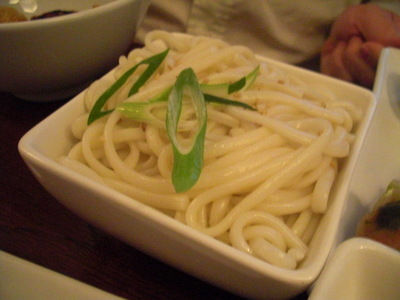 Left, jasmine rice. Right, udon noodles.
Left, jasmine rice. Right, udon noodles.
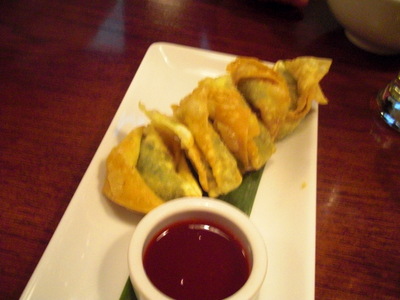
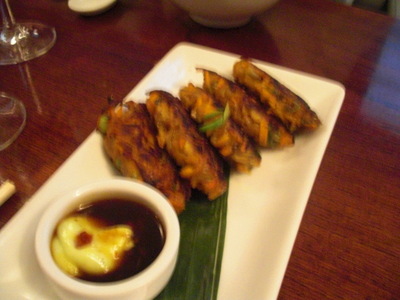 Left, crispy wontons. Right, fried green-lipped mussels.
Left, crispy wontons. Right, fried green-lipped mussels.
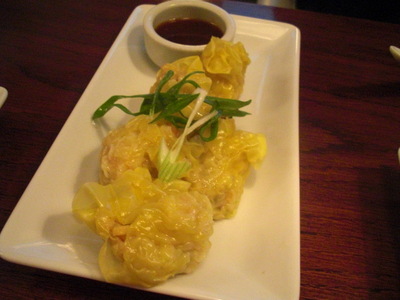
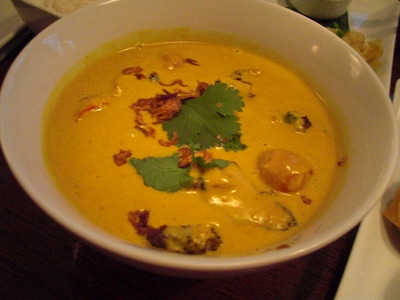 Left: steamed dumplings. Right, curry (chicken, I think).
Left: steamed dumplings. Right, curry (chicken, I think).
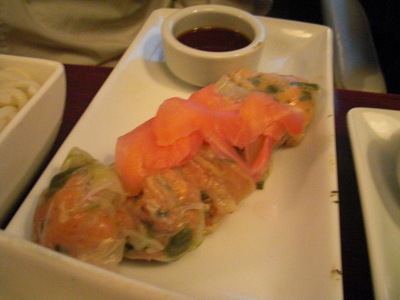
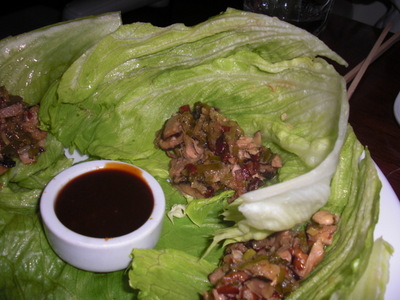 Left, salmon spring rolls (as odd as they sound). Right, chopped Peking duck in lettuce leaves.
Left, salmon spring rolls (as odd as they sound). Right, chopped Peking duck in lettuce leaves.
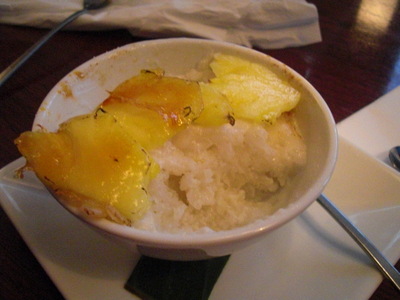 Dessert, sweet sticky rice with roasted pineapple.
Dessert, sweet sticky rice with roasted pineapple.
previous entry
List of Entries
next entry

 Thursday night, when we got back to the hotel, we both noticed a little poster in the elevator advertising an "express breakfast"—two eggs, bacon, toast, and coffee—just what we'd been wishing for all week. My attempts to find someplace outside the hotel where we could eat breakfast had not met with success—most places didn't open early enough. We had a nice continental at the Hippo, but it was ridiculously expensive.
Thursday night, when we got back to the hotel, we both noticed a little poster in the elevator advertising an "express breakfast"—two eggs, bacon, toast, and coffee—just what we'd been wishing for all week. My attempts to find someplace outside the hotel where we could eat breakfast had not met with success—most places didn't open early enough. We had a nice continental at the Hippo, but it was ridiculously expensive.
 On the way, walking along the waterfront, I stopped to admire this childrens'slide in the shape of a lighthouse. I've given this wonderful section of the harborfront rather short shrift in my desciptions, but in our various walks back and forth past and through it, we came across many wonderful features—monumental works of art, play areas, footbridges, whimsical structures like the slide.
On the way, walking along the waterfront, I stopped to admire this childrens'slide in the shape of a lighthouse. I've given this wonderful section of the harborfront rather short shrift in my desciptions, but in our various walks back and forth past and through it, we came across many wonderful features—monumental works of art, play areas, footbridges, whimsical structures like the slide.

 I had seen signs earlier indicating a "down-hill walk to the city" through the gardens, and sure enough, the volunteers on duty at the garden entrance, right next to the cablecar terminal, were eager to point out to me the pink flowers stencilled on the paths to show the way. Just at the beginning of the route was this spectacular "hand tree" (Chiranthodendron pentadactylon), in full bloom. Each "five-fingered" stamen is almost as large as a hand.
I had seen signs earlier indicating a "down-hill walk to the city" through the gardens, and sure enough, the volunteers on duty at the garden entrance, right next to the cablecar terminal, were eager to point out to me the pink flowers stencilled on the paths to show the way. Just at the beginning of the route was this spectacular "hand tree" (Chiranthodendron pentadactylon), in full bloom. Each "five-fingered" stamen is almost as large as a hand.
 Near the bottom I stopped off to tour the glass house, which is famous for its collection of begonias (left) but also shelters many other species, as illustrated by this spectacular Christmas cactus (right).
Near the bottom I stopped off to tour the glass house, which is famous for its collection of begonias (left) but also shelters many other species, as illustrated by this spectacular Christmas cactus (right).
 After wandering around for a while in the geometrically laid out rose gardens, I continued down the hill into the city, across a foot bridge over the freeway, past the post office, the behive-shaped parliament building (left), and these monumental sculptures (right) and all the way along the waterfront back to Te Papa.
After wandering around for a while in the geometrically laid out rose gardens, I continued down the hill into the city, across a foot bridge over the freeway, past the post office, the behive-shaped parliament building (left), and these monumental sculptures (right) and all the way along the waterfront back to Te Papa. 
 Left, jasmine rice. Right, udon noodles.
Left, jasmine rice. Right, udon noodles.
 Left, crispy wontons. Right, fried green-lipped mussels.
Left, crispy wontons. Right, fried green-lipped mussels.
 Left: steamed dumplings. Right, curry (chicken, I think).
Left: steamed dumplings. Right, curry (chicken, I think).
 Left, salmon spring rolls (as odd as they sound). Right, chopped Peking duck in lettuce leaves.
Left, salmon spring rolls (as odd as they sound). Right, chopped Peking duck in lettuce leaves. Dessert, sweet sticky rice with roasted pineapple.
Dessert, sweet sticky rice with roasted pineapple.